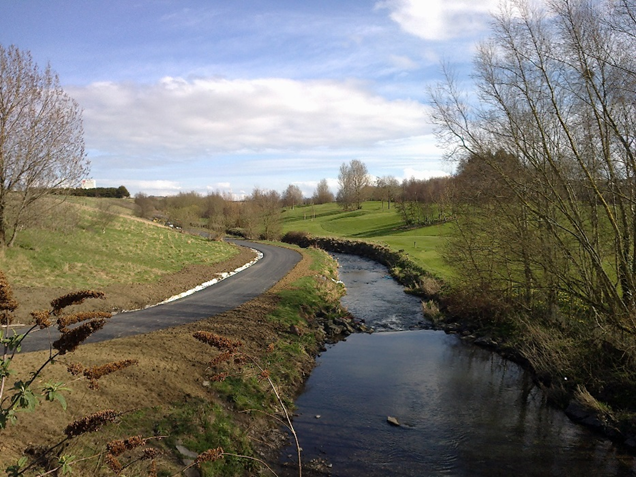
#VC19DublinCase: Tolka Valley Greenway – Exemplar of multi-disciplinary and multi-agency design of Green Infrastructure
Author: Dublin City Council
The River Tolka is one of Dublin's three main rivers. While the Tolka has a long cultural heritage, it became a polluted urban river and landfill. Over the past 10 years it has been re-imagined as a new spine of green infrastructure, which connects people and habitats.
Formerly degraded agricultural lands (18.2 hectares) were acquired in 2006-2009 and have been rehabilitated in 2010-2013 with a variety of native habitats. These additional lands have almost doubled the size of Tolka Valley Park to provide a significant green infrastructure project for the capital and public access to the river up to the City boundary.
The park is truly multi-functional, accommodating playing pitches, pitch and putt golf, cycling, access for angling and riverside walks which will now be extended by 2.4km. The site is rich in archaeological features, including the foundations of Cardiffsbridge Castle (circa 16th century) and ancient hedgerows (pre-18th century) which have been conserved. Local history and folklore associated with the river provide an important cultural dimension to the Greenway and the park.
The re-development included a 4 km off-road cycle route with potential to go future inland and to continue downstream towards a regional cycling route in progress along Dublin Bay. The cycleway required extensive site preparation and re-grading, the construction of an 18m span and a 4m span bridge, public lighting, road crossings and five new entrances. The development of the Park and cycle route linked together new planned communities with established neighbourhoods on the opposite side of the river to promote social inclusion and improve access to areas of employment and commuter railways. The total budget was €3.65 million, of which €1.4 million from development contributions from private developers of adjoining sites, and the balance from public funding sources - National Transport Authority (€1.5 million) and Dublin City Council. Participation in an EU LIFE demonstration project provided €30,000 for materials for erosion and invasive alien species control.
The river is the heart of the area once more. A major objective is the improvement of water quality for fish life including salmon and trout by fisheries enhancement measures and treating run-off from roads. Measures are implemented for water pollution prevention, erosion control, bank stabilisation and additional storage during flooding. Innovative methods for control of harmful invasive species by piloting natural fibre matting under an EU LIFE project were used. Objectives for restoration of landfills were met by using Environmental Protection Agency Guidelines for soil improvement, to stop leachate by gravel filtration strips and remedial planting of native species along the cycle route. The project provided sustainable management of the river, allowing flooding while protecting habitats, controlling quality of water entering the river and developing salmonid fisheries potential. Atlantic salmon appeared in 2011 during the construction monitoring after 100 years of absence in this section of the Tolka.
A number of protected species designated under the EU Birds and Habitats Directives - including kingfisher, otter and bats - have been recorded in the river valley which is rich in natural heritage and a haven for biodiversity in the city. To enhance habitat diversity, the park includes:
-
new integrated constructed wetlands for water quality improvement, recreation and biodiversity
-
local soils to line the wetland ponds rather than installing a plastic liner
-
fisheries enhancement measures designed in cooperation with Inland Fisheries Ireland for spawning of salmon and trout
-
seven hectares of different types of wildflower meadow were established in accordance with microclimate and soil types
-
approximately 2km of river channel planted with native species
-
over 5km of 23 native species hedgerow planted
-
over 60,000 native trees and shrubs planted and an educational Native Tree Trail
-
biodegradable matting installed to protect river banks from erosion and invasive alien species and allow native willow to establish
-
all seating in the park is made from recycled plastic
-
bat-friendly lighting is used to light the cycle route
Tolka Valley Greenway is considered an exemplar of Green Infrastructure planning as a multi-disciplinary and multi-agency design and management process which achieves tangible environmental and recreational benefits, improved biodiversity and ultimately broader quality of life gains for citizens of the City.
For more information on the Velo-city Programme, Exhibition and Registration go to: https://www.velo-city2019.com Sign up for our newsletter: https://abbey.us9.list-manage.com/subscribe?u=fd5fa9b846888ef25e85f1973&id=75273fab2e Follow us on social media: Facebook, Twitter, Instagram, LinkedIn
News category:
Network/Project Involved:
Contact the author
Recent news!
Upcoming events
Contact Us
Avenue des Arts, 7-8
Postal address: Rue de la Charité, 22
1210 Brussels, Belgium









